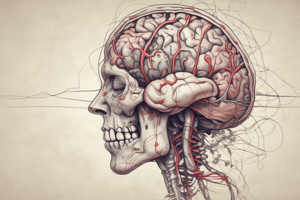Podcast
Questions and Answers
What is the brain's weight range in grams?
What is the brain's weight range in grams?
1300 - 1400
Neurons can multiply throughout a person's life.
Neurons can multiply throughout a person's life.
False (B)
Which of these structures contain ventricles? (Select all that apply)
Which of these structures contain ventricles? (Select all that apply)
- Cerebrum
- Cerebellum
- Brain stem
- All of the above (correct)
What connects the left and right cerebral hemispheres?
What connects the left and right cerebral hemispheres?
The _____ lobe controls vision.
The _____ lobe controls vision.
Which lobe of the cerebrum is associated with hearing and smell?
Which lobe of the cerebrum is associated with hearing and smell?
Match the following parts of the brain with their functions:
Match the following parts of the brain with their functions:
What is the primary function of the cerebellum?
What is the primary function of the cerebellum?
The superficial layer of the cerebellum is called the _____ cortex.
The superficial layer of the cerebellum is called the _____ cortex.
Flashcards are hidden until you start studying
Study Notes
The Brain
- It's a large, vital organ in the human body.
- Control center for thoughts, memory, emotions, and body functions.
- Located within the skull, weighing approximately 1300-1400 grams.
- Composed of neurons and glial cells.
- Neurons cannot multiply, but glial cells can.
- The brain is covered by meninges: Dura mater (outer), Arachnoid mater (middle), and Pia mater (inner).
Ventricles of the Brain
- These are cavities within the brain filled with cerebrospinal fluid (CSF).
- Four ventricles:
- Two lateral ventricles in each hemisphere.
- Fourth ventricle between the brainstem and cerebellum.
- Third ventricle between the hypothalamus and thalamus.
Parts of the Brain
- Cerebrum: Largest section, responsible for higher level functions.
- Right and Left hemispheres.
- Cerebellum: Located beneath the cerebrum, responsible for coordination and balance.
- Brain stem: Connects cerebrum and cerebellum to spinal cord, controls vital functions.
- Medulla: Controls breathing, heart rate, and blood pressure.
- Pons: Relays signals between cerebrum and cerebellum.
- Midbrain: Controls eye movements, auditory and visual reflexes.
- Diencephalon: Located between cerebrum and brainstem, responsible for sensory relay, hormone regulation, and homeostasis.
- Thalamus: Relays sensory information to cortex.
- Hypothalamus: Controls temperature, hunger, thirst, and sleep-wake cycles.
- Epithalamus: Contains the pineal gland which secretes melatonin.
Cerebrum
- The largest section of the brain, located in the upper portion.
- Responsible for thought, judgment, memory, problem-solving, language, and imagination.
- The outer layer of the cerebrum, known as the cerebral cortex, is composed of gray matter.
- The cerebral cortex is about 2-4 mm thick and contains billions of neurons.
- The cerebral cortex has folds called gyri or convolutions, deep grooves called fissures, and shallower grooves called sulci.
- The longitudinal fissure divides the cerebrum into right and left hemispheres, connected by the corpus callosum.
- Each hemisphere has four lobes: frontal, parietal, occipital, and temporal.
Lobes of the Cerebrum
- Frontal lobe: Most anterior portion, responsible for motor function, personality, speech, reasoning, planning, emotions, and problem-solving.
- Parietal lobe: Superior portion, responsible for sensory input from the skin, interpreting language, and spatial awareness.
- Occipital lobe: Posterior portion, responsible for vision.
- Temporal lobe: Lateral portion, responsible for hearing and smell.
Functions of the Cerebrum:
- Control of voluntary movements.
- Perception of pain, temperature, touch, hearing, taste, and smell.
- Intelligence, speech, memory, and learning.
Cerebellum:
- Second largest part of the brain located beneath the posterior part of the cerebrum.
- Separated from the cerebrum by the transverse fissure.
- Coordinates voluntary movements, maintains balance, and equilibrium.
External Structure
- The surface is called the cerebellar cortex, resembling a butterfly with a constricted area called the vermis.
- Lateral lobes, cerebellar hemispheres, are interconnected by the vermis.
- Each hemisphere has lobes separated by fissures.
Divisions and Layers of the Cerebellum
-
Anterior lobe
-
Posterior lobe
-
Flocculonodular lobe: Located on the inferior surface, responsible for equilibrium and balance.
-
Gray matter in the cerebellar cortex forms folds called folia.
-
White matter beneath the gray matter is called arbor vitae, resembling a tree branch.
-
Deep within the white matter are cerebellar nuclei, gray matter regions that relay information to other brain areas.
Functions of the Cerebellum:
- Coordinates skeletal muscle contractions.
- Regulates posture and balance.
- Plays a role in cognition and learning from experience.
Studying That Suits You
Use AI to generate personalized quizzes and flashcards to suit your learning preferences.



